#sauropterygia
Explore tagged Tumblr posts
Text







Plesiosaurs and Pliosaurs!
Plesiosaurus - Elasmosaurus Lindwurmia - Styxosaurus Liopleurodon - Dolichorhynchops - Kronosaurus
Stickers || Phone Wallpapers Masterlist
Planned or in the works:
#art#my art#paleoart#paleontology#science#illustration#plesiosaur#pliosaur#sauropterygia#elasmosaurus#styxosaurus#liopleurodon#dolichochynchops#kronosaurus#lindwurmia
111 notes
·
View notes
Text

A huge 6-meter-long Liopleurodon ferox ambushes an unfortunate juvenile Cryptoclidus and camps its toothy jaws upon the small plesiosaur’s head 160 million years ago in the warm, shallow seas of what is now the Oxford Clay Formation of England.
#paleoart#paleontology art#paleontology#liopleurodon#pliosaurs#plesiosauria#plesiosaur#late jurassic#jurassic period#jurassic#jurassic seas#sauropterygia#pliosaur#pliosauria#plesiosaurs#ammonite#marine reptile#marine paleontology
119 notes
·
View notes
Text
Oldest sea-going reptile from the Southern Hemisphere!

New paper by Benjamin Kear et al. (with artwork by yours truly, first time for a scientific find🤩) that documents a nothosaur that swam along the shores of an ancient polar super-ocean covering what is now the South Island of Aotearoa New Zealand 246 million years ago. This discovery reveals the early global radiation of marine reptiles, which as the authors show probably dispersed across both the southern and northern high-latitudes to dominate the world’s oceans at the dawn of the Age of Dinosaurs. The paper is open access and can be read in the scientific journal Current Biology.
#paleoart#illustration#paleontology#paleoillustration#paleoblr#palaeoblr#art#palaeontology#triassic#sauropterygia#nothosaurus#new zealand#gondwana#sea reptile
139 notes
·
View notes
Text
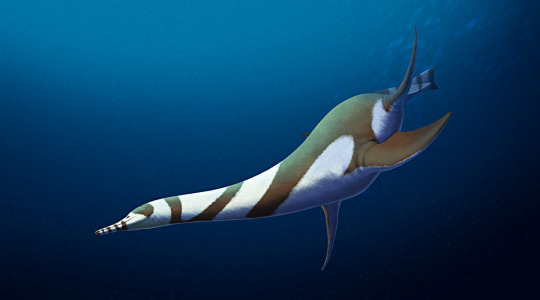
While the most iconic types of plesiosaur were long-necked with small heads and short blunt snouts, some of these marine reptiles actually developed the opposite sort of arrangement, with groups like the polycotylids and the pliosaurs independently evolving short necks, larger heads, and long snouts.
…Except some of them didn't keep it quite that simple.
Serpentisuchops pfisterae here lived during the late Cretaceous, about 70 million years ago, in the ancient Western Interior Seaway covering what is now Wyoming, USA. This 7m long (~23') plesiosaur was a member of the polycotylid lineage, but along with a long slender snout it also had an unusually long neck.
Some earlier polycotylids like Thililua had fairly long necks, too, but all of Serpentisuchops' closest relatives were short-necked species, so it seems to have actually re-evolved this condition rather than inheriting it from its ancestors. Since no other marine reptiles in its habitat had this particular body plan, it was probably occupying a very specific ecological niche – the presence of attachment points for powerful neck muscles suggest it was able to swing its head sideways to snap its jaws at prey at high speed, with its longer neck giving it more reach than other polycotylids.
———
NixIllustration.com | Tumblr | Twitter | Patreon
#science illustration#paleontology#paleoart#palaeoblr#serpentisuchops#polycotylidae#plesiosauria#plesiosaur#sauropterygia#pantestudines#marine reptile#art#long snout? or long neck?#both both is good
423 notes
·
View notes
Text
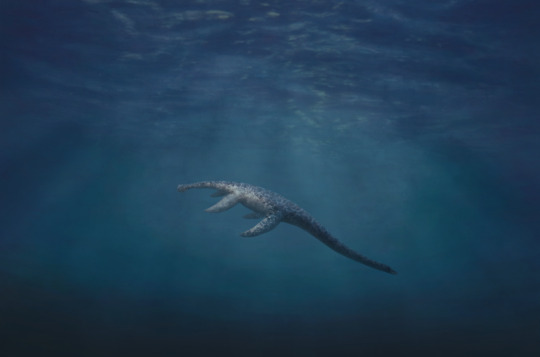
Quick drawing of the recently described plesiosaur Franconiasaurus from the Early Jurassic of Germany
#my art#paleoart#sciart#franconiasaurus#plesiosaur#marine reptile#sauropterygia#mesozoic#jurassic#germany#extinct#animal#nature#ocean#aquatic
94 notes
·
View notes
Text
youtube
NEW VIDEO!
Plesiosaurs and other Sauropterygians
__
Instagram
Youtube channel
Prints and more merch
#sauropterygia#paleoart#natural history#plesiosauria#pliosaur#nothosaurus#mesozoic#marine reptiles#Youtube
18 notes
·
View notes
Text
I apologize for such a long delay. I couldn't find the motivation to keep posting here. But, as I promised in my last post, here are three more drawings made for last year's scientific conference. :)

Front half of Dakosaurus andiniensis, massive metriorhynchid from Late Jurassic of Argentina. As with Cricosaurus, I based this reconstruction on metriorhynchid specimens with skin. Note the presence of speculative skin parasites, whose marks were founds in fossil skin. Also, there are salt glands in antorbital fenestra. This feature is based on this study: https://anatomypubs.onlinelibrary.wiley.com/doi/10.1002/ar.24678 BTW, some recons portray Dakosaurus with crocodile-like facial integument and some recons even have "lips"! I decided to diversify from these both options and did it with smooth streamlined skin.
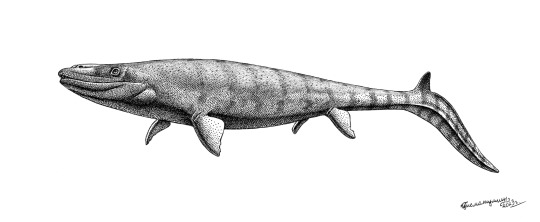
Prognathodon sp. reconstruction based on purportedly juvenile specimen with soft tissue outlines from Late Cretaceous of Jordan. This small individual was described in this paper: https://www.nature.com/articles/ncomms3423 Preserved skin impressions include silhouettes of the skin fringes of the flippers and the caudal fin. The caudal fin is quite small, but in adults it could be proportionally larger. This finding confirmed that mosasaurs converged with ichthyosaurs and metriorhynchids to develop a fish-like caudal fin.
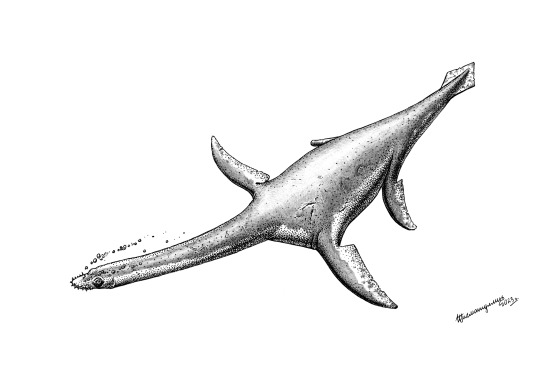
And finally, Seeleyosaurus guilelmiimperatoris (formerly species of Plesiosaurus), a microcleidid plesiosaur from Early Jurassic of Germany. Holotype of this species is almost complete specimens with some skin impressions including rhomboidal skin flap. Perhaps all plesiosaurs had caudal fins of one form or another. However, their orientation is controversial: many paleontologists are of the opinion that the fin was vertical, but others think it was horizontal.The arguments in favor of the second point of view are the rigidity of the chest, the flat and wide shape of the tail in the proximal part and the absence of bending in the distal part of the tail: https://www.researchgate.net/publication/339423536_Peculiarities_of_the_Structure_and_Locomotor_Function_of_the_Tail_in_Sauropterygia I decided to choose this version for reconstruction. Which of the scientists is closer to the truth, new findings will show. All of these drawings were done with black gel ink pen and black colored pencil with small additions of white gouache.
#dakosaurus andiniensis#dakosaurus#metriorhynchidae#thalattosuchia#prognathodon#mosasaur#seeleyosaurus#plesiosaurus#plesiosaur#sauropterygia#marine reptile#paleoart
27 notes
·
View notes
Text
Evolution of plesiosaurs (with Hatsune Miku for scale)

#nothosaurus#nothosauridae#pistosaurus#pistosauridae#plesiosaurus#plesiosauridae#plesiosauria#sauropterygia#marine reptile#paleoart#digital drawing#digital doodle#digital doodles
80 notes
·
View notes
Text
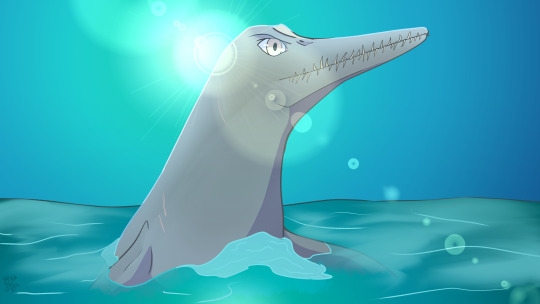
Unktaheela Specta breaching from the Western Interior Seaway on a sunny afternoon
#unktaheela specta#paleoart#dolichorhynchia#polycotylidae#plesiosauria#sauropterygia#reptilia#chordata#animalia#eukaryota
4 notes
·
View notes
Text

Jurassic June 2024 Day 7: Plesiosaurus dolichoderius
#paleoart#paleontology#plesiosauria#plesiosaurus dolichodeirus#plesiosaurs#plesiosaur#sauropterygia#marine paleontology#jurassic june 2024#jurassic june day 7#jurassic june#jurassic#jurassic period#early jurassic
36 notes
·
View notes
Text

Thank you to the amazing Riskybiscuits for this awesome artwork!
Community Creature Vote Entry - Atopodentatus - Aquatic Healer
You can vote for Atopodentatus at the link below, as well as check out the other creatures in the vote!
What is the Creature Vote?
For anyone out of the loop, Ark has been holding Community Creature Votes for every map on Ark Survival Ascended. During which community members can submit ideas and vote for new dinosaurs to be added to Ark. Once the entry period ends, the top 10 dinosaur ideas with the highest number of votes enter a multi-stage vote to determine the next new dinosaur added to Ark.
What is Atopodentatus?
Atopodentatus
Atopodentatus Unicus is the lone hammer-headed member of its own genus belonging to the class of sauropterygia, a group of marine reptiles that spanned the Mesozoic. Discovered in 2014, Atopodentatus is the only known herbivorous marine reptile from the Triassic and second in the entire Mesozoic. Its discovery has challenged some previous notions about the nature of life in Earth's prehistoric oceans.
Why the Atopodentatus?
Ark's oceans are always a resurfacing subject of conversation, with the common consensus being that Ark's oceans are lacking. A lot of the niche filled by land tames is not necessarily reflected in the available ocean tames. Meanwhile, the ocean itself exists less as a place to survive and more so an obstacle for the players to overcome while in search of specific late game resources. While this sentiment has changed somewhat in ASA, for the most part, Ark's oceans are largely the same.
Another reason players avoid the ocean is because the art of existing there is kinda tedious. Taming creatures in the ocean often involve fending off swathes of predators, which could ruin your tamed life at any moment. Thus I submit Atopo as a potential solution to that problem, as well as giving future potential as ASA grows, providing some useful abilities that can help players whether they are taming Megalodons and Mosasaurs, or fighting Moeder itself.
Active Abilities
Soothing Aoe - Atopodentatus can release an aoe that turns hostile creatures within it passive for a time. This works on wild and tamed creatures. It is useful for staving off the many predators in the ocean, and would give players a semi-safe area within which to work/tame/build etc… This ability does not work on bosses or any minions summoned by bosses.
Healing Aoe - Atopodentatus can apply a healing buff to nearby allied tames. Similarly to how Daeodon has a healing AoE, this would make Atopo a desirable creature to have along for boss fights like Moeder. This would also make Atopo the first ocean dwelling healer in all of Ark, as this ability is currently completely foreign to Ark's oceans.
Haste - While in the water, Atopodentatus can consume a small chunk of stamina to gain a sudden burst of speed, which allows it to escape fast predators as well as resurface quickly.
Passive Abilities
Stun Immune - Atopodentatus has adapted to resist the many stings and stuns of Ark's ocean creatures. Thus, Atopos are not affected by the stunning effects of Cnidaria, Electric Eel, or Baryonyx.
Archelon Algae Harvesting - Given the diet of Atopodentatus, tamed individual can be set to passively harvest Archelon Algae from tamed Archelons once they reach maximum Algae growth.
Salt Production - Given that the Atopodentatus feeds in the ocean, it consumes a lot of saltwater. In order to prevent dehydration, the atopo excretes the excess salt, which survivors can collect from the atopo's inventory. This is useful for early players to preserve food and useful for end-game players to preserve rarer/fast spoiling items like Wyvern Milk.
Biotoxin Harvesting - The secret of Atopo's tolerance for stunning effects comes partly from its ability to quickly excrete toxins from its system. When stung Cnidaria, Atopodentatus can excrete the biotoxin, for survivors go collect from its inventory.
Taming, Behavior, & Diet
The Atopo is a "sneak & tame" style tame, in which players must sneak up to the atopo while it's basking and feed it to tame it. Ghillie armor helps with this.
The Atopo's saddle is craftable at level 35, for hide, fiber, and cementing paste. It also has the capacity to have an oxygen tank attached to it for longer swims. The Atopo saddle also allows for players to utilize weapons in first person while mounted.
Atopodentatus are skittish if approached too quickly or attacked. Atopo will fight if their young are threatened. Otherwise, They can be found basking in the sun on the beaches when not in the water.
Atopo once tamed can be converted to any type of herbivorous diet. But it's taming foods as follows:
- Archelon Algae: 100% Effectiveness
- Regular (Blue) Kibble: 98% Effectiveness
- Seaweed: 95% Effectiveness, this would be a new food harvested from underwater plant nodes. This food is densely nutritious and can be consumed by survivors and herbivores tames alike for a subtle regeneration buff.
- Kelp Bladders: 95% Effectiveness, this would also be a new food harvested from underwater kelp plant nodes (which currently only give fiber when harvested). When fed to a tame or consumed by survivors it restores a small amount of oxygen.
- Berries & Crops: 85% Effectiveness
Thank you for reading!
The Atopo is a constant work in progress. If you have any comments or suggestions to improve the Atopo, feel free to write them below! Again, you can vote for the Atopo in the Creature Vote forum! All votes are appreciated!
#ark survival ascended#ark survival evolved#creature vote entry#creature vote#water tame#water dino#Herbivore#healer#ark creature vote#new water dino
9 notes
·
View notes
Text

Quick drawing of Hydrotherosaurus
#my art#paleoart#hydrotherosaurus#cretaceous#america#plesiosaur#sauropterygia#extinct#marine#reptile#ocean#prehistoric
18 notes
·
View notes
Text
Liopleurodon ferox

spec'd into big head short neck instead of small head long neck
231 notes
·
View notes
Text



Example of how our perception of very different kinds of aquatic animals changed as more discoveries were made over the decades
Basilosaurus (cetacea) Paleogene / Elasmosaurus (Sauropterygia) Cretaceous / Mosasaurus (Squamata) Cretaceous
Many more examples in my videos dedicated to this topic
__
Youtube channel
Instagram
Prints and more paleomerch
6K notes
·
View notes
Text

A fossilized reptile tooth of a Nothosaurus mirabilis from Crailsheim, Baden-Württemberg, Germany. This Triassic aged predator was a member of Sauropterygia, an enigmatic clade of marine reptiles that includes the famous plesiosaurs.
#fossils#paleontology#palaeontology#paleo#palaeo#nothosaurus#nothosauridae#triassic#mesozoic#prehistoric#science#paleoblr#首長竜目#ノトサウルス#ノトサウルス科#化石#古生物学
3 notes
·
View notes
Text
Pliosaurus funkei, going on an underwater cruise.

#pliosaurus#pliosauridae#plesiosauria#sauropterygia#marine reptile#paleoart#digital drawing#digital doodle
9 notes
·
View notes